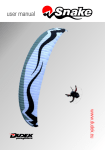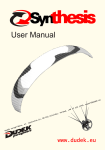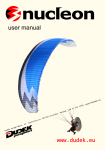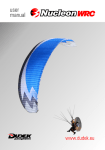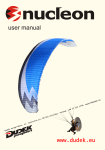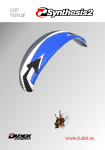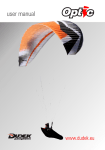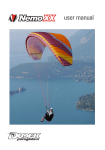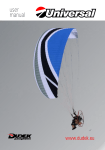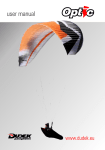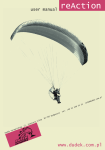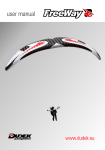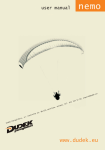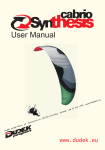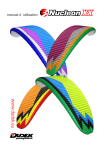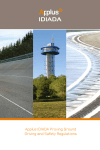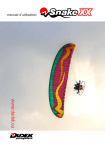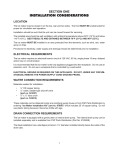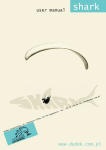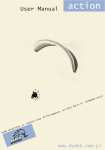Download user manual - Parastar Aviation
Transcript
user manual www.dudek.eu NOTE! Please read this manual carefully before your first flight TABLE OF CONTENTS Page 1. Introduction......................................................................................2 2. The wing..............................................................................................3 2.1 Design 2.2 Structure 3. Flight operation............................................................................7 3.1 Steering system 3.2 Before you fly 3.3 Take off 3.4 Level flight 3.5 Landing 3.6 Golden rules 3.7 Free flying 3.7.1 Take-off 3.7.2 Flight 3.7.3 Landing 3.7.4 Winching 3.8 Quick descent methods 3.8.1 Big Ears 3.8.2 Spiral dive 3.8.3 B-stall 3.9 Aerobatics 3.10 Extreme situations 3.10.1 Side collapse 3.10.2 Symetric collapse 3.10.3 Full stall and negative spin 3.10.4 Deep stall 3.10.5 Line over and cravatte 3.10.6 Emergency steering 4. Canopy care........................................................................................24 4.1 4.2 4.3 4.4 Storage Cleaning Repairs Deterioration - a few tips 5. Technical data......................................................................................32 6. Warranty, AeroCasco..........................................................................33 7. What have you bought.......................................................................35 8. Rigging tables and scheme ................................................................36 1. INTRODUCTION CONGRATULATIONS! We are pleased to welcome you among ever growing community of pilots flying DUDEK PARAGLIDERS. You’ve become a proud owner of state-ofthe-art sport PPG wing. Intensive development, application of the most modern production methods and thorough testing resulted in a friendly behaving paraglider, offering the pilot a lot of fun combined with great performance. With many years of experience we are confident to pronounce Hadron to be the best paraglider in its class. We wish you many enjoyable flight hours under your new Hadron! DISCLAIMER Please read this manual carefully and note following points: + The purpose of this Manual is to offer guidelines to the Hadron pilot and it is by no means intended to be used as a training manual for this or any other paraglider. + You may only fly a paraglider when qualified to do so or when undergoing training at an accredited school or with an instructor. + Pilots are personally responsible for their own safety and their paragliders’ airworthiness. + The use of this paraglider is solely at the user's own risk! Neither the manufacturer nor dealer do accept any liability connected with this activity. + This paraglider on delivery meets all the requirements of the EN 926-1 and 926-2 regulations or has an airworthiness certificate issued by the manufacturer. Any alterations to the paraglider will render all its certificates invalid. NOTE Dudek Paragliders warns that due to constant process of development the actual paraglider may differ slightly from the one described in the manual. In case of any doubts please contact us. 2 USER MANUAL 2. THE WING Who should fly Hadron? You are an experienced paramotor pilot, averaging several hundred flight hour a year. You can master a fast and agile paraglider. You like to play with it close to the ground (slaloms, wing-over, foot-dragging etc), you are possibly a serious competitor or world-record contender. You look for a fast and agile canopy with perfect handling and low power demand. Of course it has to be turbulence-resistant, so basically only a full reflex canopy will satisfy you. If you add to this wishlist relatively small dimensions of your dreamed wing, then Hadron is the one! 2.1 DESIGN The Hadron is dedicated for much and actively flying pilots, who are perfectly familiar with characteristics of reflex paragliders and can control them at will. Despite having similar target group as the Plasma, both those wings are considerably different. Hadron's "reflexivity" is somewhat lesser than that of the Plasma, but in return it is constant in all trimmer range. At 5,9 aspect ratio its 59 cells look relatively modest, allowing for easy inflation and perfect internal pressure distribution. Synthetic rods on its leading edge (Flexi Edge Technology) bring considerably better launch characteristics and stability at high speed Series-production Hadrons have classic steering configuration, i.e. the pilot has but two brakes at his disposal – that’s why steering system of the Hadron is called 2D. Steering lines are configured so that at low and medium speeds their geometry has little progression, thus enhancing precise canopy control. At high speeds (full trims + speedbar) only the outer steering lines should be used, alternatively you can enter some corrections via TEA system. Since the steering is divided (there are two lines at the handles, one goes through the pulley and the other directly to the trailing edge), experienced pilot can adjust brake progression to his own liking. The other systems known from our previous canopies (ALC or TST) can be used too, without much trouble at installation. Everything depends on the pilot’s wit and experience. Skill level required to fly the Hadron means that its pilots should be easily able to adjust steering system characteristics to their own preferences. Fundamental feature of a good PPG canopy should be its great stability and tuck-resistance. When this is achieved, user does not have to concentrate all the time on piloting in turbulent air, thus saving energy for navigation, taking pictures or simply enjoying the flight. In addition the faster and safer your paraglider is, the more often you can fly. While the Hadron was designed to 3 retain features of a classic paraglider, the application of a reflex aerofoil section added several new qualities. First of all, using that profile means that the wing stability does not depend exclusively on the pilot. It maintains a stable pitch attitude, rising and sinking through thermals while remaining stable above your head, without need for so much pilot input. Generally speaking, the reflex profile is a special kind of aerofoil section. The specific static pressure distribution creates a situation where at low attack angles only the fore wing part (some 60% of the chord) is producing lift, while rear 40% of the chord creates an effective stabiliser against excessive decrease of the attack angle. The trimmer system allows for considerable raising the rear part of the airfoil, thus effectively reducing its projected chord and surface area by some 15%, giving the paraglider a higher wing loading and increasing its speed. The centre of pressure also moves forward, adding enhanced pitch stability. Such shift of loading gives the Hadron an exceptional tuck-resistance and increases its projected aspect ratio, resulting in much better performance especially at high speeds. Diminished „reflexivity” of Hadron (as compared to the Plasma) is in part compensated by its smaller size for maximum take-off weight, possible due to increased wing loading factor. 2.2 STRUCTURE The body of the Hadron was designed in our CSG (Canopy Shape Guard) system, comprising many elements resulting in exceptional coherence and stability of the shape. Below you will find a short description of CSG subsystems. Hadron has an elliptical planform with slightly rearward swept tips. The cells are divided with ribs additionally supported by diagonal VSS (V-shaped supports) system. Such arrangement ensures a smooth top surface, exact aerofoil reproduction across the entire wingspan and yet more importantly, better load distribution and minimal number of suspension points. The lower surface has a RSS (Reinforcing Strap System) applied inside the canopy. RSS is a ballooning-independent reinforcements system, made entirely of paragliding fabric, stiffening and stabilizing entire canopy structure. Hadron’s aerofoil is another product of our DRA (Dudek Reflex Airfoil) technology. It was calculated with our previous experiences in mind and thoroughly tested with numerical methods. It is a reflex aerofoil, with all its properties described above. 4 USER MANUAL The suspension points areas are additionally reinforced with laminated fabric so that loads are equally distributed on three planes: vertically (through the ribs), diagonally through VSS system and level through the RSS. All crossports have been prepared using OCD (Optimised Crossports Design) technology. Carefully designed shapes of the openings and their optimal placement between stress lines guarantee very efficient pressure distribution in the canopy and its quick inflation. These openings are scaled as an entity with the ribs, so that their replicability is flawless and they do not disturb the aerofoil in any way. Another major innovation is Hadron’s use of the Flexi-Egde technology. The leading edge is closed to airflow, and its precise shape is guarded by reinforcements of laminated fabric with synthetic rods added. Their presence significantly improves the inflation and launch quality, as well as additionally guards the canopy against deformations when flown at high speeds. Cell openings are positioned on the undersurface in the vicinity of the leading edge. Their exact placement was very carefully selected, so that they got maximum ram effect in as many flight situations as possible. On the wingtips we placed the ACS (Auto Cleaning Slots) - dedicated slots automatically removing dirt from inside the wing. Careful selection of modern fabrics and design solutions brings about great strength and durability of the Hadron. All materials come from marked production batches, and each production step can be verified down to identification of specific worker and controller. Hadron is produced in new technology, utilizing capabilities of precise laser cutter. All stages of the production process take place as our Polish plant under close supervision of the designer himself, thus ensuring highest European quality. Fabric Each kind of fabric has its unique features and characteristics. We composed them so that they create a perfect blend. The upper surface is made of Porcher Evolution+ fabric (formerly named Aquatic). Basically it's a nylon material, covered with outstanding E85A impregnate. Such covered fabric is not very stiff and what's most important - has increased tear, stretch and UV resistance. It is not siliconised, so minor repairs can be easily made with self-adhesive strips. 5 Lower surface is made of 34-gram Dominico Tex cloth, contributing to low weight of the canopy. The ribs must be as rigid and stretch-resistant as possible. We found these qualities in Skytex 40 Hard with E29A impregnate. All suspension points and leading edge reinforcements are made of SR-Scrim fabric. Rigging system Almost all of the Hadron lines are unsheathed. Due to low number of the lines we made sure they are strong enough by using Technora cores, featuring high strength and stretch-resistance. The rigging system consists of individual lines looped and stitched at each end. The upper level lines start at the attachment points. Cascade-wise they are joined to main suspension lines, either directly or via middle layer lines. Main lines are attached to the risers with triangular quick links (maillons). To prevent their slipping off, the lines are kept together with a rubber 'O ring' twisted in eight. All maillons are made of corrosion resistant, polished stainless steel, ensuring excellent strength and durability. We use only the best quality, certified maillons by Peguet. Stabilo lines run from the outer suspension points to the maillons through consecutive cascades as well. The same story goes for the steering lines. They run from the trailing edge through several layers to the main lines, which are lead through the pulleys connected to the rear risers and then fixed to the brake handles. Steering lines do not carry any load. Risers For the Hadron we have chosen four-way risers equipped with: + ELR (Easy Launch Riser) system. This is an specially marked A riser (gold ribbon); + speed-system affecting A, B and C risers when engaged, featuring ball-beared pulleys and special line; + trimmers of red band with visible scale, designed for quick and easy replacement in case of deterioration; + multiple pulley positions, to be used depending on the hangpoint level; + TST (Tip Steering Toggles) – system for steering in accelerated flight via stabilizers; 6 USER MANUAL + TEA -Torque Effect Adjuster – allowing for eliminating the effect of engine torque, tending to turn the paraglider in the direction opposite to the propeller's rotation. The system can be adjusted to match your specific combination of paramotor/propeller. For quick and easy recognition in emergency, some of the risers are distinguished with coloured band as follows: A - gold (ELR riser used for launching) A' - black neoprene (used for big ears) B - red (used for B-stall) C - black neoprene D - grey (needed to keep the glider down in strong wind – aborted launch). Main A row suspension lines connect to an A riser (gold) and A' (black neoprene). B row and stabiliser lines go to B riser (red), C lines to C riser (black neoprene) and D lines to D riser (grey), as well as steering lines (through their pulleys). Brake handles are attached to the steering lines at optimal point, guaranteeing safe and effective operation. On the main brake line there are marked some more points, to be used depending on the harness hangpoint level. On adjusting the steering lines see chapter 3. Our sports steering handle for Hadron, besides its attractive, light design, features: + a swivel – preventing possible twisting of the steering line, + soft neoprene cover, + EK (Easy Keeper) system – see further pages 3. FLIGHT OPERATION 3.1 STEERING SYSTEM Steering system consist of following parts: 1. 2D - multifunctional brake system (regular steering handles) – more details on p. 20 2. TEA (Torque Effect Adjuster) - allows to compensate the engine torque by making a knot on the line and placing it in dedicated cleat. Exact position of the knot is to be determined depending on torque size in given paramotor. It is possible to pre-position several knots for typical revs ranges 7 3. traditional trimmers 4. traditional speed system Some of those part can act much the same way as ALC and TST systems known from our other designs: ALC - an outer 2D line fixed to the steering handle – you can use it alone, by grabbing just this line above the handle (the handle itself can stay in hand, can be fixed at docking station or even hang free) TST - a TEA line going through the cleat – apart of compensating torque effect you can use it for steering too, either by pulling the line directly or via TST mini-toggles (in MK3 and newer versions). Steering lines, pulleys and speed system adjustment There are as many as four positions of the pulleys provided (picture on page 9). Originally it is mounted on the risers in highest possible position (close to the quicklinks). The lowest pulley position (4) can be used in extreme cases, when it's really necessary and supported with good experience of the pilot. Note that the pulley when mounted that low does not move upwards on releasing trimmers, so considerable lengthening of the steering lines may be necessary — if they prove to be too short anyway, a longer set of the lines is to be ordered. In practice moving the pulley from highest position (1) to lower (2) does not require any adjustment of the steering lines. Moving the pulleys to even lower position (3) will definitely require lengthening the steering lines by distance between positions (2) and (3). With all these changes it is possible to adjust placement of the Easy Keeper magnets too. With highest position of the pulley, the magnet is at its highest too, and with lower pulley positions the magnet is mounted lower or even at the carabiner, as shown above. The length of the steering lines must to be adjusted so that at maximum speed configuration (opened trimmers and full speeed bar) the brakes are loose and do not pull the trailing edge. Progression of the steering lines, i.e. difference in length between the central steering line (going through the pulley) and the outer one (red) is set as standard and some pilots can regard it as not aggressive enough. You can adjust it to your own preferences, but please observe +/- 10cm range and safety rules mentioned above. Before you will take on powered flight it is recommended to try the setup out. 8 USER MANUAL Risers in lower hangpoint configuration (pulley high) Steering line D C B A' A ALC line Pulley in position (1) TEA/TST line Covered swivel Easy Keeper magnets TEA cleat steering handle Pulley in position (2) Pulley in position (3) Speed system pulleys Trimmer buckle TST handle replaceable trimmer tape Speed system hooks Pulley in position (4) Trimmer closing loop carabiner Fixing TEA line in the cleat. The knot should be placed for the best torque compensation. 9 Easy Keeper Easy Keeper is our indigenous way to hold the brake handles at the risers by strong neodymium magnets. It keeps the handles firmly at the risers, while both attaching and releasing goes smoothly and easily. The system allows for easy placing the brake handles on risers when they are not used in flight, thus minimalizing danger of getting them into running propeller. Easy Catch "Easy Catch" speedbar is a godsend for those who have problems catching the bar after taking off. The speedbar is designed to stay always in front of the speedsystem lines. Its finish is very robust, so long-term service is guaranteed. 10 USER MANUAL Hang up the entire PPG unit with ropes, sit in the harness and have someone pull up the risers. You must make sure that in flight you will always be able to reach the brake handles, even if the airflow blows them away. Being suspended in this way you have a perfect opportunity to adjust the speed system too. The speedbar should not be pulling pull its lines nor risers when not applied. Neither should it be too loose, for it could catch the propeller then. An additional way to check the whole configuration out is to visit the take-off site in steady winds of 3-4 m/s. With the engine off, inflate the wing and take it up over your head. When it stabilises, check that the brakes are completely loose and do not affect the trailing edge. There should be a spare inch or so before they activate. Remember that it is always safer to set the margin of play too big than too small. And, most importantly, the setting must always be symmetrical. Pulley in position (2) with closed trimmer; EK magnet fixed over trimmer buckle Pulley in position (3) with closed trimmer; EK magnet fixed over carabiner Pulley in position (3) with partly opened trimmer; EK magnet fixed over trimmer buckle 11 3.2 BEFORE YOU FLY Powered flight NOTE: Prior to each start a thorough check of the canopy, harness and paramotor is necessary. Correct matching of the canopy and paramotor belongs to the pilot. Dudek Paragliders cannot take responsibility for all possible combinations, but we are always there to help you – just contact us. First flights In order to get familiar with your wing we recommend flying with closed trimmers first (or slightly opened, up to 3 cm), because in this configuration Hadron behaves more like a classic wing. Flying like that try pulling the brakes some until you feel resistance, usually it will be at about 1/4 of the brake travel. Once you feel confident with your wing, you can start experimenting with faster trim settings and speed system. Learn to use all of the additional speed and safety of the Hadron. 3.3 TAKE-OFF Classic launch with no wind Even when it seems that there is no wind at all, it is rarely so. Therefore always be careful in determining the conditions, since in PPG flying it is most important that the launch and initial climb are performed with a head wind (the danger of losing your airspeed while steep crossing of the wind gradient is greatly reduced then). Special attention must be paid to trees, power lines and other obstacles, including the possibility of emerging rotors. Paraglider preparation Lay out the paraglider downwind of the power unit, with all suspension lines taut and pointing toward center of the power unit. The risers are to be laid on the ground. Set the trimmers as completely closed (0) or slightly opened up to 3 cm, depending on your preferences and weight (the scale is marked every 3 cm). In stronger conditions faster settings can be advised. Make sure that you warm up the engine while standing windward of the wing. Stop the engine before clipping in the risers. Now have a quick check if: + the helmet is on and locked, + the risers are clipped in the carabiners, + the trimmers are properly set, + nothing will get in propeller's way, 12 USER MANUAL + speed system is running without problems, + steering lines and handles are free and not twisted, + the engine delivers full power, + take off area is clear of obstacles and free to use. When you are sure everything is OK, you can clip in the wing. Move forward, evenly pulling on the A risers. The canopy has practically no tendency to overshoot, so it is hard to encounter. Instead the canopy kind of waits for you to catch up with it. From now on you should steer the paraglider facing forward, without looking back over your shoulder (when the wing is low behind you, turning can cause some lines to get in the propeller). Still, possible fall on your back and damaging the propeller is dangerous (and costly!) so it should be avoided at any price, even that of some damaged lines! During launch, when you feel the strain on both risers to be equal, open up full power and lean back to counter the engine thrust, so that it can push you forward rather than towards the ground. The best option is not to use the brakes, allowing the paraglider to rise as it was laid out. If it starts to swerve from its course, just pull the opposite riser and run under the centre of the wing while preserving starting direction. If the wind suddenly drops, give a stronger pull on the risers. If the paraglider falls to one side or back too far to be lifted again - kill the engine, interrupt launch and check the conditions once again. As the wing rises, the forces grow lighter and it should stabilise above your head without overshooting. This is the best moment to check if it is inflated OK and the lines are not tangled, but do so neither stopping nor turning. Once you feel the forces on the risers decrease, run faster and let go of the risers. See if there is already any opposition on the brakes and, if necessary, use them to correct direction or to increase lift at take-off. Remember: + If the cage of your power unit is not stiff enough, the risers strained during launch can deform it to the extent of collision with the propeller. Before giving it full power, see that the cage does not catch any lines. + Any brake operation (or steering inputs in general) should be smooth and gentle. + If the cage of your paramotor is too soft, risers strained during launch can distort it so that the propeller will hit it. Before increasing power make sure the cage is free of lines. + All steering inputs should be smooth and gradual + Do not try to take off until you have your wing overhead. Hitting power 13 before that can cause dangerous oscillations. + Do not sit in the harness until you are sure you are flying! + The faster the trim setting is, the more brake input is required to take off. + The lower the hangpoints of your power unit are, the easier is the launch. Reverse launch in strong wind Reverse launch can be executed holding in one hand both A risers and one brake, with throttle and the second brake in the other hand. With a decent wind it is by far the best way. In weaker wind it is better to prepare a classic launch, as running backwards with an engine on your back is not an easy thing to do. It is reasonable not to pull the wing up until you are really determined to launch, especially when it is clipped in. Lay down the rolled paraglider with its trailing edge against the wind. Unfold the wing enough to find the risers and check that no lines are looped over the leading edge. Stretch the risers against the wind, separating the right and left one. We suggest that you lay the risers in the same way as you will be turning during reverse launch, and place one riser over the other, with rear risers upmost. It should be done this way because once you clip in, the cage of your power unit will make turning on your own practically impossible (with the canopy lying still). Now run the pre-launch checklist. After warming up the engine put the power unit on, turn to face the wing, go to the risers and clip them in the appropriate carabiners. Pulling on the front and rear risers open the cells. It is a good idea to pull up the wing briefly in order to check that the lines are not tangled. Holding the risers, brakes and throttle as described above, pull the front risers and inflate the canopy. Hadron comes up easily and sometimes it may require a dab on the brakes to keep it over your head. Once the paraglider is stabilized and checked, you turn around, open the throttle and take off. As with the classic launch you have to find such combination of trimmers, brakes and throttle settings that will give you the best speed and rate of climb. Remember: + You are launching with your hands crossed. You have to really master this technique before trying it with a running engine on your back. + Any brake operation (or steering inputs in general) should be smooth and gentle. 14 USER MANUAL + Do not try to take off until you have your wing overhead. Hitting the gas pedal before that can cause dangerous oscillations. + Do not sit in the harness until you are sure you are flying! + The faster the trim setting is, the stronger brake input is required to take off. + When clipping in the crossed risers, you can find proper connection of the speed system particularly hard. Be careful not to confuse the risers! Climbing Once you took off safely, continue heading against the wind, using brakes to correct rate of climb. Do not try to climb too steeply - attempts to increase climb rate by pulling the brakes will have an adverse effect, as due to additional drag the actual rate of climb will worsen and with the throttle fully opened even a stall can happen. In powered flight the Hadron behaves more like an aeroplane than a paraglider, and it is good idea to regard it as such. If there are no obstacles present, it is by far safer (and more impressive for the spectators) to fly level for a while after take-off and gain some speed before converting it to height with a brief pull on the brakes. Another reason not to try climbing too steeply is the risk connected with engine failure at low altitude. Even as Hadron in a steep climb does not stay behind as much as conventional paragliders do, the low speed always can lead to a stall. Besides, at any time you have to be prepared for engine malfunction, so it's better not to take unnecessary chances and always fly with a safe margin of speed. Depending on the power unit geometry, it is possible that after take-off you will notice a propeller torque (turning moment). It will try to turn you around, so be ready to counter-steer it with a brake or harness cross-bracing. In Hadron there is our TEA system present, making possible to eliminate the torque in case when there is no cross-bracing at all. To make TEA work properly you must adjust the blocking knot accordingly to torque force. When climbing steeply with slow trim settings and high power output beware of the possibility of stall. Due to typical PPG feature - considerable vertical distance between wing chord and thrust axis - the range of safe power operation is closely related to your skills and equipment. Power-unit induced oscillations Certain configurations of engine weight, output and propeller diameter can cause serious oscillations, during which the pilot is being lifted to one side 15 by the torque effect, swings down due to his weight, then is lifted again and so on. To avoid this you can: + change the throttle setting and/or + adjust the cross bracing to counteract the torque, if there is one present and/or + use the TEA system, pulling down the knot through the tube, simultaneously blocking it in the slit and/or + shift yourself to the other side of the harness and/or + change the trimmer settings. The best method is to fasten opposite cross-bracing or apply some weightshift. Such oscillations usually occur at full power - the greater the engine output and propeller diameter, the bigger the swings. In addition there are often too late or wrong pilot reactions, increasing the problem instead of solving it. In this case the safest way to deal with this question is to close the throttle and release the brakes. 3.4 LEVEL FLIGHT Once you have gained safe height after take-off and wish to go for a route, you can turn onto right direction, fully open the trimmers and let off the brakes. If the conditions are turbulent, it can look foolhardy, but this is the essential feature of the reflex profile - the faster you fly, the safer your Hadron is. That's why it's really possible to release the brakes and enjoy your flight. CAUTION: Some pilots with previous free-flying experience may have a well-grounded habit of keeping the brakes slightly applied at all times. Such technique, while quite reasonable on a free-flying wings as it allows for quick pilot reactions and reduces sink, is not advisable on reflex-profile paragliders. When you pull the brakes, the Hadron profile loses its reflex characteristics. If you have a variometer or altimeter aboard – watch it. In level flight it is very easy to start climbing unintentionally. The instruments will help you optimise speed your and fuel economy. Good knowledge of weather conditions (e.g. wind at different altitudes) and smart use of thermals, convergence or other kinds of lift will help you greatly reduce fuel consumption and increase flight range. Trimmers and speed-system operation The reflex wing airfoil enables the Hadron pilot to use a wide range of trimmers and speed-system action. You are free to experiment with all possible settings, as long as you keep safe altitude. 16 USER MANUAL Speed configurations Basically we can discern three speed configurations, depending on trimmer settings and speed-system operation: a) Slow mode (trimmers closed): - steering with regular brakes b) Accelerated mode (either trimmers opened or speed-system engaged, but not both at once!): - steering with regular brakes (although that may require some strength) - use of the ALC line will be more effective (the outer branch connected to main brake line) c) Full speed mode (trimmers opened and speed-system engaged): - pilot should never use neither main brakes, nor ALC line, - steering must be done with TEA/TST line only! These are the basic guidelines only. As a whole, the combined 2D/ALC/TEA/TST system is very versatile and every pilot will find his own way to use it. However, we strongly collect at least several flight hours first, in order to get fully acquainted with the Hadron. Speed system of the Hadron works exactly the same way and has the same range as trimmers system. Speed and trimmers are fully exchangeable in operation, so their exact proportion will depend on pilot's preferences only (considering the above mentioned rules of speed modes are kept) Speed system can be safely used in all trimmer positions. Reflex profile The Hadron has full reflex profile already with closed trimmers. Releasing the trimmers and/or using speed system further enhances that feature. Flight - trimmers closed (slow mode): Steering is done with main brake handles. You can pull them straight down along your body or sideways, away from your body, thus differentiating the progression and bank angle. 1. Straight down along your body - bigger progression, sharper turns. 2. Away from your body - lesser progression, turns with less banking. 3. Combined technique - "inner" hand along the body, "outer" hand moves away to keep central part of the canopy solid and stay ready for necessary corrections. Flight - trimmers off or speed-system engaged (accelerated mode): In general, steering is the same as described above. However, a lot more force is needed, so you should consider grabbing the outer steering line above the handle. In this way you will be steering mainly via the outer part of steering system (much like ALC). While on long routes, it is definitely recommended to steer using only the TEA line directly (low hangpoints) or via TST handle placed at lower end of TEA 17 (high hangpoints). TEA line works exactly like the TST system - you got "two in one" here. With low hangpoints some pilots can find the TST handle superfluous. In such case it can be taken off completely, and the end of TEA line can be permanently fixed at DCT docking station. Flight - trimmers off and speed-system engaged (full speed mode): Due to relatively high aspect ratio of the Hadron and consequent short aerodynamic chord of the wingtips, steering the paraglider with main brake handles at full speed configuration becomes impossible – all attempts to use the main brakes will have no effect other than evoking collapses. As such, this is not dangerous, it will even hardly alter the flight path (given that pilot won't be keeping the brakes down for long). However, this phenomenon is undesirable, unpleasant and - most of all - not effective as a means of directional corrections. It follows that steering at full speed should be done only with the TEA line (low hangpoints) or TST handles (high hangpoints). Those systems do not distort the reflex profile, guaranteeing safety and efficiency of operation. Every pilot should find out for himself how much trimmer can be let out before steering with main brakes at full speedbar becomes impossible, or alternatively - how much speedbar can be used with trimmers fully opened. This will depend on a number of factors, including size of the canopy. Finding that range is especially important in case of slalom competitions. Common technique calls for flying at full speedbar and specific trimmer setting which enables good canopy control without any collapses. When exiting sharp turns the speedbar has to be pressed too, since not doing so will result in rapid climb on dangerously high attack angle, with associated risk of losing lift and entering stall or deep stall. In practice, pilots have found out that in smaller sizes (20 and 22, most often used for slalom) trimmers release that still guarantees stable flight amounts to some 3 cm. In each individual case this setting can be different and it is possible that even greater release of the trimmer will allow safe use of main brakes in fast mode. Whenever you fly at high speed - be it on open trimmers or speedbar - smooth steering inputs are recommended. In accelerated flight of the reflex canopy the last rows of suspension lines often happen to be slack. Abrupt pulling on the steering handle causes immediate change of pressure & trimming of the aerofoil, resulting with rapid collapse. At slower trim settings both the sink and steering forces are reduced, so that effective thermalling becomes possible. 18 USER MANUAL Various steering modes Steering with main brake toggles only (slow or accelerated mode) The toggle has different effects when pulled down vs. away (details on next page). Main toggle + ALC line (accelerated mode) Variable steering progression depending on degree of operation. Steering with ALC line only (accelerated mode) Main steering toggles can be docked on the magnets or let free. Steering with TEA/TST line (required in full speed mode): - use the TEA/TST line only (with main steering toggle still in hand or docked), or; - use TST mini-toggles (depending on height of the hangpoints The TEA line can be used for torque effect compensation too. 19 2D steering system – examples of operation Below you can find basic modes of steering with 2D system. Demonstrated examples are by far not a complete catalogue – there is a lot of interim configurations and only the pilot will choose what kind of steering is the best in given situation. 2D steering is considerably different than the classic steering system. The possibilities it offers are of special value for competition pilots. On one hand the 2D system offers much more precise control of he canopy, but on the other it requires learning new (different) reflexes and reactions. Pilot must spend some time exploring the system and perfecting his own technique before flying 2D in demanding environment of the competitions. ALC line 1 pulley Conventional turn - pull down vertically on one toggle 3 4 Strong slow-down with central part - pull both toggles sidewise Extreme slow-down with central part - pull inner lines down 5 6 Tight turn - pull down the outer ALC line 20 2 Conventional slow-down - pull down verticaly on both toggles Deep turn - pull down the inner brake handle and the outer toggle a little bit aside USER MANUAL Please study pictures illustrating trimmers and speed-system operation on the next page. They explain the influence of various settings on the profile shape. Remember: + Trimmer setting is another thing to include in your pre-flight check list! + If the setting is not symmetrical, the paraglider will turn in flight. And if you inadvertently release the trimmers, reflex profile of the Hadron will keep your wing level, so after hitting the gas you will descend with increased speed instead of intended climbing. 3.5 LANDING In paramotor flying there are two kinds of landing: with and without power. Power off landing At an altitude of 50 metres switch off the engine and glide as you would on a conventional paraglider. It reduces the chances of damaging the propeller on landing, but on the other hand there is only one attempt possible - so it has to be done right! Set the trimmers as fully closed (0) or slightly released (2 to 3 cm), depending on individual preferences and weight of the pilot (same position as you would for launching). Since wing loading of the Hadron is usually higher than of our other paragliders, landing with slowed-down canopy with little speed should be definitely avoided. In contrast, a full-speed landing with flare is recommended. Hadron is very efficient at converting airspeed for lift, so you can glide a long way slowing down with gradual increase on the brakes. Finally the level flight is stopped and soft touch-down ensues. Powered landing Make a flat approach with the engine idling, then level out and lose the speed before final flare. Immediately after touchdown switch off the engine. The main advantage of this procedure is of course possibility of repeated approach if anything goes wrong. Still, if you forget to switch off the ignition before the wing falls down, there is considerable risk of damaging propeller, catching lines in it or even suffering injuries connected with falling on your running engine. Remember: + Whenever possible, get to know the landing field before taking off. + Check the wind direction before planning the approach. + Landing with power off requires much less space. + In case of any doubt, practice the landing until you feel totally safe. 21 Influence of classic steering on the reflex profile Pilots used to classic paragliders tend to fly "active" style, with their brakes constantly tensioned. Flying a reflex wing like that is ineffective and can possibly be dangerous. Basic rule of reflex paramotoring says: the more turbulent it is, the more trims should be released and classic steering should be limited, especially with speed system engaged. In such moments paraglider is much more effectively steered by TST or ALC systems, designed specifically for that reason. Problem is illustrated by following drawings: Released trims without brakes Typical setting for fast and safe flying. Center of pressure of the aerofoil moves forward, practically excluding collapses. Pitching moment induced by the reflex aerofoil increases angle of attack. Released trims with brakes applied Even slight brakes application (especially on full speed bar) shifts the center of pressure back, and due to lack of reflex on trailing edge, pitching moment now decreases angle of attack. Additionally turbulence behind the wing occurs. In some circumstances this can lead to a collapse. Using the brakes can be sometimes necessary for heading corrections, still you should keep your brakes free when flying ahead, otherwise the reflex feature doesn't work. Closed trims In this configuration brakes are the normal and prescribed steering system. Slow trim is used for launching in nil wind and thermalling. The canopy behaves similar to classic profile paragliders, with slightly increased tuck resistance. lift speed pitching moment center of pressure sink 3.6 GOLDEN RULES + Never place the power unit downwind of the paraglider. + Check, double check and then check once again if there is no fuel leakage. + Do you have enough fuel for the flight? It is always better to have too much than too little! + Check if there is nothing loose in the harness, that could possibly contact the propeller in flight. + Whenever you encounter a problem, fix it AT ONCE however small it is! + Always put on and lock the helmet before getting in the harness. + Before each launch run a full pre-flight inspection. 22 USER MANUAL Trimmers and speed-system influence on the aerofoil Slow mode Trimmers fully closed (0) Speed-system inactive Slowest speed, Minimum sink. Launch configuration Accelerated mode Full speed mode Trimmers fully opened Speed-system inactive (alternatively speed-system engaged with closed trims) Trimmers fully opened Speed system engaged Increased speed neutral length of all risers: 490mm Trimmer: A - 490 A’ - 515 B - 540 C - 585 D - 630 C D D B Maximum speed A' A Speed: A - 320 A’ - 350 B - 380 C - 435 D - 490 C B A' A Trimmer + Speed: A - 320 A’ - 370 B - 420 C - 525 D - 630 D C B A' A 23 + After landing, control the wing facing the direction of flight, as on turning you always risk getting lines in the propeller. Turn only if there is danger of falling on your back. + Don't ask for trouble - do not fly over water, between trees or power lines and other places where engine failure will leave you helpless. + Mind the turbulence caused by other gliders or even by yourself, especially when flying low. + It is not reasonable to let go of the brakes below 100 meters, because a possible power unit malfunction may require immediate attention. + In general never trust your engine, as it can stop at any moment. Always fly as if it's exactly what it's going to do. + Unless it is absolutely necessary (e.g. collision avoidance), do not execute tight turns against the torque direction. Especially when climbing you can easily enter a stall and consequent negative spin. + Do not fly with tail wind at low altitudes, as it pretty much narrows your options! + Do not wait for the problem to grow - any change of engine sound or a vibration can indicate troubles. You'll never know until you land and check it out! + Be certain of your navigation + Remember that not everyone is fond of your engine noise. Do not scare the animals. 3.7 FREE FLYING (NO PARAMOTOR) Even as the Hadron was designed as a fast PPG paraglider, it displays surprisingly good behaviour as a classic paraglider and can be used as such without any modifications. The main difference between Hadron and other paragliders is that due to increased resistance to collapses (during launch as well as the flight) and wide range of operational speeds it can be safely flown in stronger conditions too. In general the faster you fly, the safer your paraglider is. 3.7.1 Take-off In case of forward launch we recommend that after spreading the canopy all lines be taut. Hadron is launched A risers only. The optimal setting of the trimmers is completely closed (slow), in case of strong wind they can be released a bit. Now move forward, evenly pulling on both A risers. The paraglider practically does not overshoot, so you will rarely encounter frontstalls (quite often otherwise). Instead the canopy kind of waits for you to catch up with it. Reverse launch – we recommend the trimmers to be set as described above. 24 USER MANUAL Due to no overshooting tendency the launch is easy, requiring only minimal brake application before turning. Reverse launches can be executed even with wind as weak as 1,5 m/s. IMPORTANT! Always during launch you have to pull your wing over your head. The reflex aerofoil used in Hadron has inherent tendency to increase the angle of attack, so the paraglider can stay behind the pilot if he will not careful at this point. 3.7.2 Flight Hadron's enlarged speed range may initially demand some attention. However, once you have mastered these additional aspects, flying will become pure pleasure. Good handling will let you make the best use of thermals, and increased speed on glides means that your presence in sinking air will be shorter. In order to avoid stalls when braking with slow trims setting, their movement is restricted by the tape sewing. (Note: it is possible to push the sewn tape through the buckle with both hands to replace it, but in normal operation trimmer range must remain limited!). When the trims are fully opened the wing becomes faster and stiffer, increasing its stability even more. The brake forces grow too, as well as the distance to the stall point. The radius and bank angle in turns increase proportionately to the growing brake forces. If the trims are set fast (or fully opened) and the wing is not flown near the ground, a switch to TST/ALC steering is advised. Those system can be used at all trimmer and Speer system settings, it can be also combined with main brakes use.i ustawienia trymerów i speed systemu, także łącznie z głównymi sterówkami. Speed system operation Full application of the speed system increases flight speed by some 30%. In contrast to most paragliders it does not decrease wing stability, in fact the Hadron seems to counter the turbulences even better. Still, if you meet some serious trouble, it is advisable to release the speedbar. With application of the speed system the brake forces grow, while brake effectiveness decreases considerably. At maximum speedbar and fully opened trims we strongly recommend steering with ALC system. Turns executed in this way will be slightly wider, but strength needed to initiate the turn will be smaller and there will be no decrease in speed. 3.7.3 Landing With closed trimmers (slow mode) Hadron lands like any other paraglider. The brake forces, initially low, are growing proportionally through entire range, 25 giving ample warnings before possible stalling. Nevertheless, you should always be careful when flying very slow, until fully familiar with brake operation. When landing with trims set fast (above "0" point), bleeding off speed can require more space than usual. The paraglider has lots of kinetic energy and careless application of brakes may even cause the wing to climb. Most pilots get to know the wing relatively fast and quickly gain enough trust to fly it in stronger conditions than they ever did. Still, you should always be careful when flying low. Remember that Hadron flies faster than ordinary paragliders and sometimes it can be of importance (e.g. when landing on a slope). After landing in strong wind the paraglider can be safely put down with B risers, or with a strong pull on the rear D risers. 3.7.4 Winching Hadron was not designed for winching. The reflex aerofoil used in this paraglider has inherent tendency to increase the angle of attack. While in normal flight such a disposition makes it safer, it can be dangerous during winch start. Nevertheless, a lot of successful winches on have been made. To sum it up: winching can be done, but proper attention must be paid. 3.8 QUICK DESCENT METHODS 3.8.1 Big Ears In order to get the Big Ears you have to pull down the outer lines of the A' risers (distinguished by neoprene sheath) by some 20-50 cm. While inducing big ears you should never let the brakes out of your hands. After tucking the tips in, paraglider will continue to fly straight with increased sink rate (up to 5 m/s). You can steer the wing pretty efficiently by weight-shifting. After releasing lines, the paraglider will usually open up on its own or you can assist it with a long stroke of the brakes. For the sake of safety (the possibility of a parachutal stall) it is reasonable to engage speed system after pulling big ears in order to lessen the angle of attack of the wing centre. Executing big ears with opened trimmers is very difficult due to reflex profile stabilisation. CAUTION: See the PARACHUTAL STALL chapter. Never try to pull big ears during powered climb, as the increased drag can cause excessive angle of attack and a parachutal stall. Besides, pulling the ears while climbing is pointless anyway. 26 USER MANUAL 3.8.2 Spiral dive Hadron is a very agile paraglider, so entering spiral dive happens very quickly and can be surprising for the less experienced pilots. A spiral dive is characterised by reaching the highest sink rates possible. Significant G-forces, however, make it difficult to sustain for long, as it will place high loads on both pilot and glider to degree of losing consciousness by the latter. Never do this manoeuvre in turbulence or at too high bank angles. Control the dive and do not exceed 16 m/s sink. If the dive is not stopping after releasing the brake, assist the paraglider with the outer one. NEVER DO BIG EARS IN A SPIRAL! In this manoeuvre smaller number of lines is carrying an excessive load multiplied by centrifugal force, what can lead to damage of the lines or even the paraglider itself (load of a single line can be much higher than tested in certification trials (i.e. 8G). 3.8.3 B-STALL To enter a B-stall, simultaneously pull down both B-risers (red tape) by 10 – 15 cm. The canopy will collapse across the entire span along its B-row, the airflow over top surface will break and projected canopy surface will be decreased. Forward movement will be almost completely stopped. Further pulling B-risers is not advised, as tests have shown it to increase wing instability. If the canopy forms a horseshoe with both wingtips in front of the pilot, gently apply both brakes to recover. To exit a B-stall, the risers should be released in a smooth and decisive manner. On quick and symmetrical releasing B-lines the airflow will be reinstated and the wing will surge forward, returning to normal flight. In contrast to standard paragliders, in case of Hadron there is no need to counter this surge with brakes - yet another asset of the reflex profile! CAUTION: See the PARACHUTAL STALL chapter. All rapid descent techniques should be practiced in smooth air and with sufficient altitude only ! Full stalls and spins are to be avoided as recovery procedures, since irrespective of paraglider type they may have dangerous consequences! BY FAR THE BEST TECHNIQUE IS SAFE AND CORRECT FLYING, SO THAT YOU WILL NEVER NEED TO DESCEND RAPIDLY! 3.9 AEROBATICS Hadron was not designed for doing any aerobatics. 27 Wing over You make a wingover by performing a series of consecutive, alternating turns with growing bank angle. Too much banking connected with some flaws in coordination and execution can evoke pretty dynamic collapse. CAUTION: Steep turn with bank angle over 60 degrees is a prohibited aerobatic manoeuvre! 3.10 EXTREME SITUATIONS CAUTION: Due to high resistance of the Hadron against both side and front collapses, we strongly recommend not to provoke such situations during safety trainings. Inducing collapses can be very hard to impossible in standard way, while unconventional attempts can result in extremely violent and dynamic behaviour. PROVOKING EXTREME SITUATIONS SHOULD TAKE PLACE ONLY DURING SAFETY TRAININGS UNDER SUPERVISION OF A QUALIFIED INSTRUCTOR! WHILE UNDER EXTREME CIRCUMSTANCES THERE IS HIGH PROBABILITY OF TOO STRONG OR TOO HASTY STEERING INPUTS. THAT'S WHY YOU SHOULD ALWAYS EMPLOY GOOD JUDGMENT, STAY CALM AND TAKE MEASURED ACTIONS! Since all actions required to exit or prevent dangerous situations are typical and pilots flying Hadron should already have proper experience, we are going to describe only the characteristic features of the Hadron. Description of standard methods dealing with extreme situations can be found in textbooks. 3.10.1 Side collapse When the trimmers are fully opened or the speed system is engaged, collapses practically do not occur and can be induced only by a very strong turbulence. Still, if it happens, a little counter-steering is enough to keep the canopy on course. Under normal conditions with collapses up to 50% of the wingspan, Hadron will reinflate instantly and spontaneously. If not, you should aid this process by application of brake on the collapsed side. 3.10.2 Symmetric collapse (frontstall) The reflex profile of the Hadron makes it practically impossible, especially at higher speeds. During tests we succeeded in creating this situation only with fully closed trimmers and using special measures. Such forced collapses can lead to extremely deep collapses, so recovery will require decisive pilot action (short and equal application of both brakes). 28 USER MANUAL 3.10.3 Full stall and negative spin May happen only as a result of serious neglect or intentional action of the pilot. You have to be careful when flying at low speeds until fully familiar with brake operation. Wing recovers spontaneously in initial phase of stall, otherwise use standard procedures. 3.10.4 Deep stall Under normal conditions does not occur. If you want to prevent it happen at all, simply stick to a couple of rules: + after B-stall, release the risers quickly and evenly. Don't be afraid Hadron does not jump forward excessively. + after big ears execution, engage the speed system. This will increase both the sink rate and safety margin, as big ears constitute an effective aerodynamic brake with significant loss speed. Nevertheless, if such a parachutal stall happens e.g. due to strong turbulence, simply apply some pressure on speed bar and/or push the A risers forward. You can release the trims too. 3.10.5 Line over (cravatte) Hadron is a modern wing which, in order to decrease drag, has fewer suspension lines and greater distances in between. Therefore it's always possible that after a tuck one of the stabilisers may tangle in the lines. Usually a couple of pulls with a brake settles the matter. If it's not enough, try to untangle it with big ears or a stronger pull on the risers. In case of any doubts you should seriously consider a rescue chute. It is there as a normal equipment part, not just an ornament. 3.10.6 Emergency steering In case of any malfunction that renders normal steering impossible, you can safely steer and land Hadron using the D-risers (grey marking) or stabilo lines. 29 4. PARAGLIDER CARE Proper looking after your paraglider will prolong the life of your Hadron. 4.1 STORAGE Hadron's design incorporates newest technologies, including nylon lines in the leading edge. That's why the paraglider should be carefully packed, with proper conditions ensured for transport and storage. Basic rules to be followed when folding the canopy: 1. Fold it accordion-wise rib to rib (cell by cell). Do not fold it by halves, placing the stabilizers at the centerline. 2. When a compact package is crated on the longest chord do not roll it, but fold three to four times, from trailing edge towards the leading one. 3. The leading edge reamins on top of folded canopy. Store the paraglider in a dry place, away from chemicals and UV exposure. Never pack or store the glider when wet. Remember that the wing becomes damp also while lying on green grass in direct sunlight. A good precaution to avoid dampness and/or UV when you have to wait in a start queue is to use quick-pack after rigging up. Always dry the glider thoroughly before packing and/or storage. Never pack you paraglider too tightly. While drying, never expose your paraglider to direct sunlight operation. Please note that with frequent kiting/groundhandling exercises your paraglider will deteriorate faster due to its repeated rising, falling and being dragged on the ground. 4.2 CLEANING Clean the paraglider with water and a soft sponge. Do not use any chemicals or alcohol, as these can permanently damage the fabric. 4.3 REPAIRS Repairs should only be carried out by the manufacturer, authorised distributor or authorised workshop. It is acceptable to fix minor cloth damage with selfadhesive patches included in the package. 4.4 DETERIORATION - A FEW TIPS The paraglider is made mainly of nylon - a fabric which, like any other synthetic material, deteriorates through excessive exposure to UV rays that come with the sunlight. 30 USER MANUAL Hence it is recommended to reduce UV exposure to a minimum by keeping the paraglider packed away when not in use. Even when packed in a bag, it should not remain in the sun for long. Hadron's suspension lines consist of Technora inner core and polyester sheath. Submitting them to excessive loads in flight should be avoided, as it can cause irreversible damage. Keep the paraglider clean, since getting dust in the lines and fabric will reduce their durability. Be careful to keep snow, sand or stones from entering the cell openings: their weight can slow or even stall the glider, while sharp edges can damage the cloth. Prevent lines from catching anything, as they can overstretch or tear. Do not step on the lines. Uncontrolled strong wind takeoffs or landings can result in the leading edge of the canopy hitting the ground hard, which may seriously damage the ribs, sewing and surface material. Knots can chafe suspension and/or brake lines. Check line lengths after tree or water landings, as they can stretch or shrink. Measurement should be taken at the manufacturer or authorised workshop. After landing in water you should check the wing fabric as well, since the wave forces can cause the fabric to distort in some areas. When taking the wing out of the water, always do this by trailing edge, so that water can flow out freely. After a sea landing, rinse the paraglider with fresh water. Since salt crystals can weaken the suspension lines even after rinsing in fresh water, you should replace the lines with new ones immediately after contact with salt water. Every second year Hadron should undergo technical inspection by the manufacturer or authorised distributor. Strength of the unsheathed lines should be controlled after every 100 flight hours, after 200 hrs or two years complete line set should be replaced. 31 5. TECHNICAL DATA Hadron Certification 20 22 24 26 28 - - - - - Load test [kg] 1179 Number of cells Surface area (flat) [m 2 ] Surface area (projected) [m 2 ] 59 59 59 59 59 20,00 22,00 24,00 26,00 28,00 17,36 19,10 20,83 22,57 24,30 Span (flat) [m] 10,86 11,39 11,90 12,38 12,85 Span (projected) [m] 8,78 9,21 9,61 10,01 10,38 Aspect Ratio (flat) 5,90 Aspect Ratio (projected) 4,44 Sink rate [m/s] min = 1,0; trim = 1,2-1,7; max = 2,8 Speed [km/h] min = 24; trim = 38-51; max = 62 Max. cord [cm] 227,93 239,06 249,70 259,89 270,49 Min. cord [cm] 36,51 38,30 40,00 41,63 43,33 Distance pilot to wing [m] 7,01 7,34 7,67 7,98 8,28 335,00 351,00 368,00 383,00 398,00 50-70(120)* 65-85(140)* 80-105(160)* 95-120(160)* 110-140(160)* 50-120 65140 80-160 95-160 110-160 5,2 5,6 5,8 6,0 6,5 Total line lenght [m] Weight range [kg] Weight range DGAC [kg] Weight of the wing [kg] Lines Edelrid A-8000U: 025 & 050 & 120 & 200; 7343-280 Fabric Porcher Evolution+ 40 g/m2 Dominico tex 34 g/m2 Porcher Hard 40 g/m2 SR Scrim, SR Laminate 180 g/m2 Risers PASAMON - Bydgoszcz, Polska ()* Maximum allowable take-off weight for slaloms, acrobation etc. CAUTION: the paraglider considerably alters its behaviour depending on the wing load. Maximum loads require employing highest pilot skills. 32 USER MANUAL 6. WARRANTY AND AEROCASCO Purchase of a new paraglider is a serious expense for any pilot. That is why we cover our paragliders with extensive warranties and optionally offer an AeroCasco insurance against damage and repair costs. WARRANTY Dudek Paragliders guarantees free of charge repairs caused by the material or production faults along following scheme: For the free-flying paragliders warranty covers 36 months (3 years) or 300 flight hours (whichever comes first). If the free-flying paraglider is used for powered flights, every hour spent in the air should be counted double (does not apply to dedicated PPG canopies). For the PPG paragliders warranty covers 24 months (2 years)/200 flight hours (whichever comes first). For the mountaineering (MPG) and speedflying wings as well as school and profit users warranty covers 18 months (1.5 year)/150 flight hours (whichever comes first). WARRANTY DOES NOT COVER: + fading or other colour changes of the canopy + damage caused by chemicals or salt water + damage caused by incorrect use + damage caused by emergency situations + damage resulting from accidents (airborne or not) WARRANTY IS ONLY VALID IF: + flight hours are correctly registered in logbook of the owner (and possible earlier owners), distinctly marking PPG flights, + the paraglider is used in accordance with operating manual, + the purchaser has not carried out any repair by him/herself (excl. minor repairs with self-adhesive patches), + the purchaser has not modified the paraglider in any way, + the canopy can be correctly identified with nameplate data, 33 If you have bought your paraglider second-hand, ask its previous owner of the paraglider for a logbook copy (it's total of flying hours since the date of first purchase that counts most). AEROCASCO Normal warranty does not cover repairs of damages caused by the user or a third party. Since costs of such repairs can be considerable, Dudek Paragliders offers an AeroCasco insurance. It covers a one-off repair of any mechanical damages, no matter how big and whoever inflicted them. The only expenses of the purchaser is shipping and socalled share-of-cost amount. AeroCasco can be purchased only for brand new paragliders (at the paraglider purchase). Its cost is 50 euro. NOTE: AeroCasco is not available for all paragliders (check this before purchase). It can be obtained for privately used wings only. AeroCasco applies only to damages which took place during take-off, flight or landing. Obviously, all faults in the material and manufacturing flaws are covered by normal warranty. When handing the paraglider for the repair you have to attach a card confirming its AeroCasco status. After the repair you will have to cover only the share-of-cost value of 50 euro. AeroCasco is valid for one repair only. There is a possibility to extend AeroCasco for one more year. To do this you have to send your paraglider for inspection not later than a year after the date of purchase. Extension fee is 75 euro (incl. inspection). Remember to attach the AeroCasco confirmation when shipping the paraglider. Note: aditional inspection does not extend the full inspection validity. AeroCasco does not apply to any of the following: theft, colour fading, damage caused by incorrect storage or transport, damage caused by chemicals, salt water and force majeure. 34 USER MANUAL 7. WHAT HAVE YOU BOUGHT The Dudek paraglider you've purchased should have the following items: + the paraglider itself (canopy, lines and risers). + transport bag (with compression strap). + MotoBag backpack. + speed system with Easy Catch bar. + a windsock. + a pocket with paper work and repair wallet including: # A piece of self-adhesive fabric (10 cm x 37.5 cm) for small repairs. Note that even small tears located in vicinity of the stitches have to be repaired by an authorised service # A looped and stitched suspension line longer than the longest used in paraglider, which is to be used as a temporary replacement. Do not cut it if you have to replace a shorter line, just tie it at the length needed # A paraglider passport with entered date of purchase and valid technical inspection (please check the serial number with the sticker on the wing tip) # The User Manual you are reading $ Small gifts. MotoBag MotoBag is a dedicated solid backpack for PPG wings, made of proven Cordura fabric. Simultaneously it doubles as a quickpack if necessary. Beside comfortable shoulder straps to hold it traditionally on your back it has side handles too, so that you can carry it like a suitcase when needed. After turning it inside out, becomes a quickpack that will shelter your unfolded wing when you are in a hurry. 35 SUMMARY If you will respect the rules of safe flying and proper glider care, you will enjoy many years of pleasant airtime. Still, you must be aware of possible dangers and face them wisely. You must accept the fact that all air sports are potentially dangerous and your actual safety depends solely on you. We insist that you fly safely, and this concerns both the weather choice and safety margin during all manoeuvres. FLYING THE PARAGLIDER IS ALWAYS YOUR OWN RESPONSIBILITY. SEE YOU IN THE AIR! 8. RIGGING SCHEME Rigging (suspension lines) scheme is on the next page, while tables of lines' lengths are published on our website www.dudek.eu Lengths are measured with a specialised, computer-operated device. All lines are stretched with a 5 kg load before cutting. Thanks to abovementioned device and proper procedures, final tolerance of line lengths does not exceed 0.15%. CAUTION!!! Distances given below are to be understood as distances between connection points. When cutting a line for repair, 20 cm extra must be added as at each end a 10 cm stitch is required to fix the loop. The only exception is the main steering line (brmain), which is looped only at the upper end, while there is 20 cm left on the lower end for fastening brake handle (this means for this line extra 30 cm is needed). Length of the steering line is given for high hangpoints scenario (longer brakes). In case of lower hangpoints the line is shorter by some 15 cm (brake handle is fixed higher on the line). 36 USER MANUAL 37 38 leading edge trailing edge mini-ribs intakes steering lines main lines Wloty Cela ribs Fot. Iwona Dudek V 15.03.2012 MADE IN EUROPE Dudek Paragliders ul. Centralna 2U 86-031 Osielsko, Poland tel. (+48) 52 324 17 40 [email protected] www.dudek.eu












































